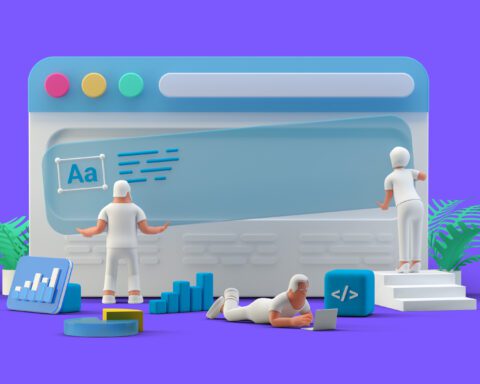Modern businesses are constantly seeking new ways to adapt and take advantage of the latest technologies. One such advancement in the realm of web development and content management is the headless Content Management System (CMS). This novel concept is making waves and causing many to question traditional CMS’s relevance. But what exactly differentiates a headless CMS from a traditional CMS? Is one truly superior to the other? This article will explore these questions about Headless CMS vs Traditional CMS.
What is the Difference: Headless CMS vs Traditional CMS?
To understand the difference, it’s essential first to define what each type of CMS entails.
A traditional CMS, also known as a coupled CMS, is a system where the back-end (where content is created and managed) and the front-end (where that content is presented to users) are intrinsically linked. Popular examples of traditional CMSs include WordPress and Joomla. This coupling allows users to create content, manage it, and see exactly how it will display to the end-user in one seamless platform.
On the other hand, a headless CMS decouples the back-end content layer from the front-end presentation layer. This approach essentially removes the ‘head’ (the front-end, or ‘presentation’ layer) from the ‘body’ (the back-end, or ‘content’ layer).Content stored in a headless CMS can be delivered anywhere, through any framework, because it is API-first. It’s called ‘headless’ because the content is completely separated from the ‘head’ or presentation layer. Examples of headless CMSs include Contentful and Prismic.
The key difference between a headless CMS and a traditional CMS lies in this decoupling. A traditional CMS is tied to one particular presentation layer — the one built into the CMS. In contrast, a headless CMS is entirely independent of the presentation layer, allowing developers to deliver content to any device or channel via APIs.
Is Headless CMS Better?
The question of whether a headless CMS is ‘better’ largely depends on your unique needs and circumstances. However, several factors make a headless CMS an attractive option for many businesses.
A headless CMS offers unprecedented flexibility. As the content is separate from the presentation layer, developers are free to use any programming language to build the front end. They can push content to any channel, including websites, mobile apps, IoT devices, and more. This flexibility can be instrumental in providing a consistent, omnichannel user experience.
Headless CMSs also facilitate faster content delivery. As they are API-driven, content can be pushed quickly and efficiently to multiple channels at once. This is a significant advantage in today’s fast-paced, multi-device digital landscape.
Lastly, headless CMSs enable scalability. Since they’re built on modern technology stacks and are often hosted in the cloud, they can scale on demand, making them a robust choice for large, growing businesses.
However, declaring the headless CMS as categorically ‘better’ wouldn’t be fair or accurate. Traditional CMSs have their strengths and continue to be the right choice for many businesses. They typically offer a more user-friendly interface, ideal for non-technical users. They also come with out-of-the-box themes and plugins that can speed up website development. Moreover, with a traditional CMS, what you see is what you get – the coupling of the content and presentation layers allows content creators to see how the end product will look in real-time.
What is the Drawback of Headless CMS?
Despite the flexibility, scalability, and speed that a headless CMS offers, it isn’t without its shortcomings.
One major drawback is that it can require more technical expertise to implement and manage. With the decoupling of the front-end and back-end, you’ll need developers to build and maintain the front-end presentation layer. This could involve extra costs and resources, making it less feasible for small businesses or teams without extensive technical knowledge.
Secondly, headless CMSs often lack the out-of-the-box features that traditional CMSs provide. Many standard functionalities, like form creation, SEO management, or user authentication, need to be manually coded or incorporated through additional services, increasing the complexity of your tech stack.
Lastly, the fact that a headless CMS does not have a built-in front-end means previewing content can be challenging. Content creators may find it difficult to visualize how their content will appear to the end-user. Some headless CMS platforms offer a preview feature, but it might not be as accurate. Alternatively, live previews available in traditional CMSs are reliably accurate and easy to use.
Why Would You Need a Headless CMS?
Despite these potential drawbacks, there are compelling reasons why you might need a headless CMS.
The primary reason is the need for omnichannel delivery. Headless CMS makes it easier to manage and deliver that content seamlessly across multiple platforms.
If your business demands highly custom interfaces or has unique requirements that cannot be met by traditional CMSs, a headless CMS offers the flexibility you need. With the freedom to design the front-end independently, developers can create tailored user experiences.
A headless CMS also proves beneficial when you have a large scale application. The scalability and performance optimization offered by these systems are better suited to handle substantial traffic and data loads.
Finally, if you are a large scale organization check out our article on Enterprise CMS Platforms that can offer you some of the high level features that smaller scale CMS platforms may not include.
Conclusion
Choosing between a headless CMS and a traditional CMS is no small decision. Each has its unique advantages and disadvantages, and the best choice will depend on your specific needs, capabilities, and future plans.
Headless CMSs, with their decoupled architecture, offer increased flexibility, omnichannel content delivery, and scalability. However, they can be more complex to manage, lacking some of the user-friendly, ready-to-use features of a traditional CMS.
Remember, the goal isn’t to choose the ‘best’ system in a generic sense but to select the one that best fits your business model, content strategy, technical capabilities, and future growth plans.
As we continue to navigate the ever-evolving digital landscape, the choice between a headless CMS and a traditional CMS will become an increasingly common consideration. By understanding the intricacies of Headless CMS vs Traditional CMS you can make an informed decision that best supports your content management needs and overall business objectives.





